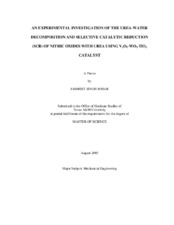An experimental investigation of the urea-water decomposition and selective catalytic reduction (SCR) of nitric oxides with urea using V2O5-WO3-TiO2 catalyst.
Abstract
Two flow reactor studies, using an electrically heated laminar flow reactor over
Vanadia based (V2O5-WO3/TiO2) honeycomb catalyst, were performed at 1 atm pressure
and various temperatures. The experiments were conducted using simulated exhaust gas
compositions for different exhaust gases. A quartz tube was used in order to establish
inert conditions inside the reactor. The experiments utilized a Fourier transform infrared
(FTIR) spectrometer in order to perform both qualitative and quantitative analysis of the
reaction products.
Urea-water solution decomposition was investigated over V2O5-WO3/TiO2 catalyst
over the entire SCR temperature range using the temperature controlled flow reactor.
The solution was preheated and then injected into pure nitrogen (N2) stream. The decomposition
experiments were conducted with a number of oxygen (O2) compositions (0,
1, 10, and 15%) over the temperature range of 227oC to 477oC. The study showed ammonia
(NH3), carbon-dioxide (CO2) and nitric oxide (NO) as the major products of decomposition
along with other products such as nitrous oxide (N2O) and nitrogen dioxide
(NO2).
The selective catalytic reduction (SCR) of nitric oxide (NO) with urea-water solution
over V2O5-WO3/TiO2 catalyst using a laboratory laminar-flow reactor was investigated.
Urea-water solution was injected at a temperature higher than the vaporization
temperature of water and the flow reactor temperature was varied from 127oC to 477oC.
A FTIR spectrometer was used to determine the concentrations of the product species. The major products of SCR reduction were NH3, NO and CO2 along with the presence
of other minor products NO2 and N2O. NO removal of up to 87% was observed.
The aim of the urea-water decomposition experiments was to study the decomposition
process as close to the SCR configuration as possible. The aim of the SCR experiments
was to delineate the effect of various parameters including reaction temperature
and O2 concentration on the reduction process. The SCR investigation showed that
changing parameter values significantly affected the NO removal, the residual NH3 concentration,
the temperature of the maximum NO reduction, and the temperature of complete
NH3 conversion. In the presence of O2, the reaction temperature for maximum NO
reduction was 377?C for ratio of 1.0.
Subject
Selective Catalytic Reduction (SCR)Nitrogen Oxides (NOx)
Urea (NH2CONH2)
Fourier Transform Infrared Spectrometer (FTIR)
Citation
Johar, Jasmeet Singh (2005). An experimental investigation of the urea-water decomposition and selective catalytic reduction (SCR) of nitric oxides with urea using V2O5-WO3-TiO2 catalyst.. Master's thesis, Texas A&M University. Texas A&M University. Available electronically from https : / /hdl .handle .net /1969 .1 /2595.


